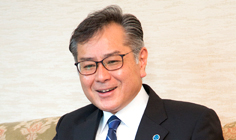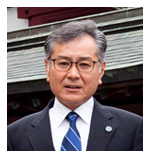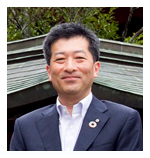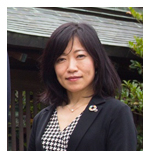Dialogue Achieving a Sustainable Society and Resolving Social Issues

- Host:
Located in Munakata City that is facing the Sea of Genkai at the northeast of Fukuoka Prefecture, Okinoshima, also known as "the island where God resides," together with other associated sites, were inscribed on the UNESCO World Heritage List in 2017.
The World Heritage site is made up of a number of sites. They include the three shrines of Munakata Taisha enshrining the Three Female Deities of Munakata, which are said to be the origin of the belief in gods residing on the island of Okinoshima that lies near the middle of the Sea of Genkai; the three shrine precincts on Okinoshima; Okitsu-miya Yohaisho on Oshima that is facing Okinoshima; and Shimbaru-Nuyama Mounded Tomb Group where the people who have built the tradition of worshipping are buried.
Inheriting the indigenous faith of Japan that has been passed down since ancient times, the people of Munakata believe that it is their duty to hand down this valuable cultural heritage to the next generations. However, the global environment has changed as time goes by.
Today, we would like to talk to Takayuki Ashizu (Chief Priest, Munakata Taisha), Masanori Ozawa (General Manager, Kyushu Corporate Division, NTT West) and Mieko Hara (Manager, Environmental Management and Promotion Office, NTT West), who are also engaging in the environmental issues of Munakata City to learn more about the environmental conservation activities and "achieving a sustainable society and resolving social issues" from their respective stances.
Thank you for your time today.

About Munakata Taisha (Origin, Shinchoku (Divine Decree), etc.)
- Host:
The shrine precincts exude a commanding atmosphere. With a stately main shrine building and carrying the prestigious title of "michinushinomuchi," Munakata Taisha, which is one of the three Munakata Shrines, is a collective term for the three shrines. Could you explain this to us in greater detail?
- Ashizu:
In the myths of Japan as described in "Kojiki" (An Account of Ancient Matters) and "Nihon Shoki" (The Chronicles of Japan), it was mentioned as one of the old shrines which appeared in one of the oldest myths. This suggests the significance of the shrine. It was one of the rare shrines that received a "go-shinchoku" (divine decree) from the ancestor of the imperial family represented by "Amaterasu-ナ稽ikami," who is enshrined at Ise. In Nihon Shoki, it was mentioned that the Three Female Deities of Munakata descended to the land of Munakata and were enshrined there following the Divine Decree that ordered them to descend to the land of Munakata to assist the successive emperors, and by doing so they would be worshipped as deities by the emperors.
Munakata was the first place in Japan that opened up to the world, and could be said to play the roles of diplomacy, trade and defense in the present-day context with interaction and trade starting from the Korea Peninsula and spreading to Mainland China. It is believed that the Deities of Munakata were worshipped by the Yamato Imperial Court to honor the success in foreign interaction and trade. Archaeological remains also suggested traces from the 4th to 7th centuries and 8th century. Some 80,000 items of national treasures were excavated from Okinoshima (the island where God resides). This tells us that the most prestigious items were dedicated to the Deities of Munakata by the Imperial Court at that time.
The Three Deities of Munakata - Tagorihime, Tagitsuhime and Ichikishimahime, are being enshrined respectively in Okitsu-miya located on Okinoshima that is about 60 kilometers away from mainland Kyushu, Nakatsu-miya on Oshima which is also the biggest island in Fukuoka Prefecture, and Hetsu-miya of Munakata Taisha.
Environmental Conservation Activities in Munakata
- Host:
Mr. Ashizu, you have been tackling "problems concerning the natural environment" as part of your lifework. The sixth "Munakata Eco-100 International Symposium" was held in August this year. Can you tell us how you feel and share with us some episodes when the symposium was first inaugurated?
- Ashizu:
I returned to Fukuoka, my hometown, after being away for several decades, and this year is the seventh year since I moved to Munakata. Before returning, I used to engage in work related to forests and other environmental problems in Tokyo for more than 30 years. While the scenery of Munakata still looked the same, I heard from those in the fishery industry that the sea was in a dilapidated state. As such, I talked to Mr. Tanii, the former mayor of Munakata City who was promoting inscription on the World Heritage List, and expressed the view that we need to be open about the current state of the sea area around Okinoshima and the associated sites, which is also known as the buffer zone. Subsequently, the "Munakata Eco International Symposium" was inaugurated six years ago.
Back then, we engaged in two projects, one to pick up plastic wastes to address the problem of trash that was washed ashore, and the other to make bamboo reefs for fishes. For bamboo reefs, we were impressed by the efforts of students from Fukuoka Prefectural Suisan Marine Studies High School in Fukutsu City, who cut down bamboo plants that were causing a problem at the satoyama (village forests) and sank them into the sea to create spawning sites for fishes. We attached iron as weight to the bamboo reefs as they would disappear with time. While it is difficult to analyze from a scientific perspective, there were cases where iron was used to create seaweed beds, and we learned from Nippon Steel Corporation, who had more than 10 years of experience in creating seaweed beds by sinking iron into the sea, to extract iron from accumulated trash in Munakata, and sink them into the sea as weights. While the reefs will only function for a limited period of time, the iron slabs will continue to function as seaweed beds.
- Host:
I believe NTT West Group is also promoting environmental activities, am I right?
- Ozawa:
We recently attended the "Munakata Eco-100 International Symposium" which we have been taking part in since 2017. Through the panel discussion, we learned details about how marine plastic wastes and other wastes and trash that are washed ashore or dumped into the sea would impact marine life.
NTT West Group sets a goal to reduce the final disposal rate of wastes generated by us to less than 1%. To do so, in addition to separating the collection of PET bottles used at our offices, we also clean and inspect the plastic network termination units that we have collected during the use of our Hikari services for reuse and recycling instead of discarding them. Also, as a member of the local community, we also mobilize all our staff to take part in activities to clean up pine forests and beaches as well as weeding in the mountains.
Registration as a World Heritage Site
- Host:
Mr. Ashizu, I understand that you have also put in efforts for "Okinoshima of Munakata" - the island where God resides - and other associated sites to be inscribed as a World Heritage site.
- Ashizu:

The first round of screening was conducted by "ICOMOS," an international research organization specializing in archaeological studies, while the final decision on the inscription as a World Heritage site was made through voting by the ambassadors of the 21 UNESCO member states.
Demanding reviews were received during the screening phase by ICOMOS, and we had to restructure the logic as a result in less than a month before the World Heritage Committee session held in Krakow of Poland. We concluded that it was faster to find keywords that are applicable to the ambassadors from 21 countries taking into consideration the need for them to understand a different culture, and decided to narrow down to three keywords, namely "Spiritual," "Animism" and "Ecology."
While "Shrine Shinto" falls into the category of "religion" from an academic viewpoint, the definitions of religion and shinto seem alike but are in fact different in nature. As such, an English friend who was visiting Japan advised me to "express Shrine Shinto in a Spiritual way," which is why we adopted "Spiritual" instead of "religion" to represent Shrine Shinto. Next, while Shinto has a shrine building, this was introduced due to the influence of Buddhism after it was being imported into Japan. Prior to this, objects such as rocks and trees were deemed to be represent and symbolize divine spirits. In the case of Munakata, traces of nature worship can still be found, which is why we thought of "Animism" as a keyword. The third keyword is "Ecology." Rearranging the sequence of the three words into "Spiritual, Ecology, Animism" coincidentally forms the acronym of "SEA," which struck a chord in us.
We could not get our message across at first because we tried to incorporate too many details, and identifying common keywords helped to facilitate communication. We have heard of cases where some countries decided to withdraw from the World Heritage List because they had difficulties managing and preserving the said site, but our perception is more positive. In the question about the protection of properties including those in the buffer zone, we were highly rated for our marine regeneration projects. We were told that Munakata is the only World Heritage site that engages in such activities, and that this serves as a useful reference for UNESCO. This was one of the key reasons for the inscription.
- Host:
So you were able to capture the heart of the representatives from the different countries with very short keywords, and highly commended for our environmental conservation efforts.
- Ashizu:
As I have mentioned at the beginning, our ancestors from Munakata were the point of contact with foreign countries, and I believe they communicated through gestures and short strings of words back then. In the end we adopted the same approach as our ancestors.
From this experience, we have learned that we should deepen communication in our future exchanges with foreign countries through straightforward keywords instead of making things complicated from the beginning.
- Host:
There still remain strict rules on Okinoshima. Wouldn't it be challenging for foreigners to understand these aspects?
- Ashizu:
While Japanese tend to interpret World Heritage sites as entities that are visible and tangible, the objective of World Heritage is to "protect and pass them down to future generations" and show respect for cultures. Foreigners have a clearer understanding that we should not recklessly touch things that are important and must maintain them in the current state.
Environmental Management of NTT West Group
- Host:
Next, I would like to hear about the initiatives of NTT West Group in areas such as Environmental Management.
- Ozawa:
We have declared in our CSR report that NTT West Group aims to become a company that contributes to the reduction of environmental burden by the entire society. Specifically, we hope to promote solutions that make use of ICT to help lighten the burden on the environment as solutions for resolving social issues.
- Host:
Ms. Hara, could you explain to us your endeavors as a company that engages in activities in pursuit of sustainable development?
- Hara:
NTT West Group releases yearly reports on our CSR and environmental activities in the form of CSR reports and on the website. We also see this round of talk as a valuable opportunity for us to communicate thoroughly with and hear from our stakeholders.
As a provider of telecommunications services to our users in Japan, NTT Group is a corporate group that consumes an extremely large amount of power, which is close to 1% of the commercial power consumption in the entire country. As such, we are striving to reduce power consumption and prevent global warming as part of our environmental management endeavors. Our efforts to conserve electric power has resulted in a decrease in the amount of power consumed every year, and we have achieved a reduction of approximately 20% compared to FY2010.
This year, we made some major revisions to our environmental goals to engage in initiatives that are in alignment with the government of Japan by establishing a long-term goal for the reduction of greenhouse gas emission. Meanwhile, we are also taking part in forest thinning as well as activities to clean up the sea and beaches as part of our endeavors to protect the nature. We also gave a talk at the "Munakata Eco-100 International Symposium" last year.
- Ashizu:
One of the distinctive features of the "Munakata Eco-100 International Symposium" is that it transcends boundaries to involve not only the government, administrative bodies and NPOs, but also private sector organizations including NTT West Group, Nippon Steel Corporation, Toyota Motor, as well as the local Shabondama Soap.
Efforts for Achieving a Sustainable Society and Resolving Social Issues of the Local Community
- Host:
Next, I would like to ask about your efforts to resolve social issues faced by the local community.
- Ozawa:
NTT West Group uses "Social ICT Pioneer" as a keyphrase to indicate the direction that the company should pursue, and we hope to consistently engage in business activities as a member of the local community and make contributions toward building an affluent society from a "community-centered" approach both as individual employees and as a corporate entity by utilizing ICT to address the different social issues. We believe our vision is in line with the "SDGs" as shown on the badge we are wearing today.
- Ashizu:
I believe companies are more advanced with regard to environment-related efforts. As a shrine, we are also consistently reminding ourselves to contribute to the local community, and since the territory of our shrine is also home to the deities of Munakata, who are known to be the "sea deities," we hope to be as actively involved as NTT West Group in such activities.
- Host:
You mentioned about engaging in initiatives that aim to conserve and protect the environment with the use of ICT. Can you explain this in greater detail?
- Ozawa:

The workforce in the forest industry is constantly decreasing each year. In order to protect the forests, we need to manage them properly and perform thinning as needed. Otherwise, dilapidation of the forests without proper monitoring of their state may also disrupt the ecosystem in the vicinity as a result. As such, we have been conducting surveys and analyses on the forest resources using drones and GIS. Thanks to the advancement in technology, simply by flying a drone to capture the forests from above, we can obtain a three-dimensional view on the screen for identifying the angle of the slopes as well as the number of trees growing in a specific area. We are currently making use of drones to conduct such demonstration experiments on forest management through an industrial-academic collaboration in Miyazaki Prefecture to perform the necessary maintenance upon understanding the state of the forests. As forests occupy an extensive area in Japan, we hope to roll this out to other parts of the country.
- Host:
There is a diverse array of environment-related issues to be tackled, and it would be difficult to resolve them all at once. It is reassuring to hear that companies are engaging in efforts to address these issues one by one.
- Ashizu:
The theme of the 2019 Eco Symposium is "Forever Young."
I have also been engaging in efforts to tackle environmental issues, and while technology innovations continue to make progress, it is also important to consider the frame of mind for revolutionizing technology. Since early times, Japan has been worshipping different gods, believing that they are present everywhere around us, such as in plants and the sea. In fact, this used to be a universal perception among mankind, and was not something unique to Japan. By bearing this in mind as we engage in technological innovation, I believe we will be able to develop new technologies that are friendly to the environment. There is now a better understanding toward the concept of Animism in other countries too, and it has also become a global trend to believe that we will not be able to make progress in environmental conservation and protection without such values. I believe that reaffirming the individual spiritual components between companies and civilians like us will contribute to the development of even better technologies.
- Ozawa:
At the recent "Munakata Eco-100 International Symposium," Mr. Ashizu mentioned something along the lines of "at the end of the day, environmental issue is an issue of our heart," and what you said today has helped me to see the point in a new light. As a company, we will continue to engage in our business activities while bearing in mind the spirit of "forever young," which is the theme of the symposium, as well as "to preserve the cycle" and "symbiosis."
- Hara:
"Issue of our heart" is a compelling phrase indeed. As a company, one of our challenges is how we can help as many individuals as possible to achieve symbiosis with the environment in their lifestyles.
Ending Remarks
- Host:
Thank you for sharing the great stories with us today.
Last but not least, I would like to ask each of you about your impression of the talk today.
- Ozawa:
Given this opportunity to share my thoughts here today, I now feel even more compelled with regard to my mission to engage in environmental efforts. I want to take advantage of this occasion to work even harder, and I look forward to your continued support.
- Hara:
I learned that Munakata is spreading information to the world on its efforts concerning the marine environment, and it was a great lesson for me to learn about the ways to carry out the activities as well as the attitude toward the local community.
- Ashizu:
National boundaries do not exist when it comes to issues related to the sea, and the broad network is what we can rely on.
Currently, we are building our world cultural heritage network with many other countries, and it would be reassuring if we can receive guidance about our overseas network from NTT West Group, who is the network innovator.
- Host:
Thank you for your time today.

[Guest Profile]
 |
Takayuki Ashizu, Chief Priest, Munakata Taisha Joined Munakata Taisha in April 2012. Promoted to Gonguji (assistant chief priest) in 2013. Promoted to chief priest in June 2015. His lifework revolves around issues concerning the natural environment. |
 |
Masanori Ozawa General Manager, Kyushu Corporate Division, NTT West |
 |
Mieko Hara Manager, Environmental Management and Promotion Office, Technological Innovation Department, NTT West |


